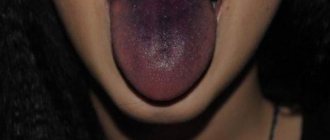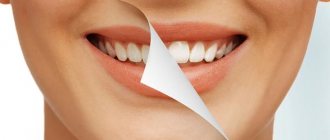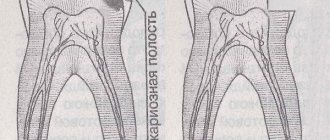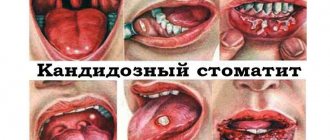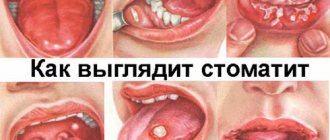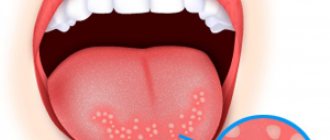Causes
Why do white spots appear on gums in adults? The mucous membrane may change color due to:
- stomatitis;
- candidiasis;
- leukoplakia;
- cysts.
If a white spot on the gum of an adult hurts, it is even more unpleasant, so the help of a doctor is required. This phenomenon also has other reasons:
- the appearance of a wen;
- fibrinous plaque after tooth extraction.
The appearance of a white spot on the gum can be accurately determined by its appearance and structure. In any case, treatment must be carried out under the supervision of a specialist.
Methods of treatment and prevention
A white spot on the gum can be caused by a variety of pathological conditions. Only a dentist can prescribe the correct treatment.
The treatment method directly depends on the type of disease:
- For stomatitis, your doctor may prescribe antiviral drugs. If the process is caused by an allergic reaction, then antihistamines are prescribed. In the fight against stomatitis, decoctions of medicinal herbs are very effective.
- If white plaque on the gums is a consequence of professional teeth enamel whitening, then you should rinse your mouth every day for several days with decoctions of strengthening medicinal herbs.
- If a patient has a fistula caused by inflammatory processes, it can be eliminated by treating caries or pulpitis or removing the affected tooth.
- For leukoplakia, it is recommended to stop using tobacco products and sharpen the sharp edges of teeth or dentures. Experts recommend treating the oral cavity with keratolytics, applying an oil solution of retinol, and taking vitamin A for 1 to 2 months. If this pathological condition is not treated, there is a possibility that it will become malignant.
- If the white spots on the gums are caused by a cancerous or precancerous condition, then to confirm this fact, the doctor will most likely send the tissue for a biopsy. Unlike cancer, a wen, as a rule, does not pose any danger, but it is better not to try to get rid of it on your own.
Treatment of caries is one of the ways to overcome white spots on the gums of an adult
Timely diagnosis of the defect will help to detect pathology in time, begin treatment and avoid the development of complications.
zubdental 01.08.2017
However, not all formations are harmless. There are many oral diseases whose symptoms include sores or white spots on the gums. In order to quickly respond and take the right treatment measures, it is necessary to become familiar with the signs of common oral ailments.
Stomatitis
If the white spot on the gum has a dense coating that cannot be removed, then it is more likely that it is stomatitis, when the oral mucosa becomes inflamed. The mechanism of occurrence of the disease has not been reliably established, but most doctors attribute it to an immune reaction to irritants that affect the oral mucosa.
Lymphocytes attack unidentified particles, which is why first areas with a white coating appear in the mouth, and then painful ulcers in their place. Swelling of the mucous membrane is also observed. Hyperthermia and pain are likely to occur. White spots can appear from:
- bacterial or viral infection;
- mechanical damage to the mucosa;
- vitamin deficiency;
- poor quality or poorly installed dentures.
Due to stomatitis, salivation decreases: due to dehydration, taking specific medications, or excessive oral hygiene. Stomatitis requires treatment prescribed by a doctor, only then will you be able to get rid of unpleasant symptoms.
Preventive measures
The appearance of a pimple on the gum is provoked by various situations. Consider the recommendations of a specialist that will help reduce the risk of unpleasant symptoms:
- Regular and and mucous membranes.
- Timely removal of plaque from the gums. After cleaning, they must be massaged. You can do this with your finger. Active circular movements improve blood circulation.
- Reduce consumption of very spicy and salty foods. They irritate soft tissues, causing disruption of tissue integrity.
- Do not consume too hot food or drinks.
- Doctors recommend giving up bad habits as quickly as possible.
- If the bristle of the brush is too hard, it should be replaced.
- Regular visits to the doctor will help keep your mouth clean and promptly identify problems with the health of your teeth and gums.
All pimples and spots on the gums are treatable. Therefore, it is very important to seek help in a timely manner.
Candidiasis
If a white spot under the gum is easily removed with a cotton swab, but appears again after a while, then this is considered a sign of candidiasis. Candidiasis or thrush is a lesion of the mucous membrane by Candida fungi.
Fungal microorganisms of this kind are present in the normal microflora of the mouth, so the disease does not appear when they penetrate the mucous membrane, but when they multiply intensively. This is usually observed with reduced immunity or dysbacteriosis. Pathological proliferation of fungi is associated with:
- vitamin deficiency;
- decreased immunity due to severe illnesses, especially infectious ones;
- lack of iron;
- dysfunction of the endocrine system;
- dysbacteriosis of the oral cavity.
Candidiasis develops with a decrease in salivation and an increase in the acidity of saliva (this condition is noticed in many gastrointestinal ailments). This disease requires treatment to prevent complications.
Leukoplakia
If in adults the white spots on the gums are dense, have a milky tint, or are presented in the form of a cluster of small scales, then this is a sign of oral leukoplakia. It is not considered an independent disease; it is a syndrome in which thickening and keratinization of the epithelium of the mucous membrane occurs.
Leukoplakia appears as a reaction to aggressive factors:
- trauma to the mucous membrane from sharp teeth or poorly installed dentures;
- frequent long-term consumption of hot or spicy foods;
- smoking;
- prolonged exposure to harmful chemical components.
This syndrome also appears with a deficiency of vitamin A. The danger of leukoplakia is that it can turn into cancer if left untreated. The first sign of a malignant tumor is a graying and clouding of the white spot.
White plaque on the gums (candidiasis) –
If your gums turn white, then you can suspect not only leukoplakia, but also oral candidiasis, in which a white coating may appear on the gums, tongue, mucous membranes of the cheeks and palate. Candidiasis is caused by fungi of the genus Candida. Most often it occurs against the background of reduced immunity, endocrine diseases, gastrointestinal diseases, anemia, hypovitaminosis, diabetes mellitus, HIV infection, chronic hepatitis, and smoking.
Long-term use of antibiotics and mouth rinses containing antibiotics and antiseptics can also lead to candidiasis. The presence of untreated carious teeth, inflammation of the gums, and poor oral hygiene also plays a big role in the occurrence of candidiasis.
White plaque on gums: photo
Cyst
This phenomenon is not always noticeable on the surface, but sometimes you can notice white spots on the teeth near the gums. A cyst is a formation in soft tissue. This is a cavity inside the gum, in the walls of which there are modified cells.
Usually there is pus in this cavity. A dental cyst occurs due to infection of soft tissues, as well as due to their pathological growths.
Fibrinous plaque
If a white spot appears on the gum after tooth extraction, the cause may be fibrinous plaque. But this is almost an isolated case when such a symptom does not indicate a disease, but the healing of a postoperative wound.
Fibrinous plaque is presented in the form of dead epithelial cells, which covers a new growing layer. No treatment is required; during healing, it disappears on its own without consequences.
Herpes infection
Many people have the herpes virus; often it does not manifest itself throughout life. It often affects children 3-5 years old. Herpes can be in acute and chronic form. The reasons for its occurrence are associated with poor hygiene and close contact with the carrier. In adults, the disease appears from stress, colds, weak immunity, and sudden changes in weather conditions.
Herpes infection manifests itself in the form of a small rash of white blisters, which can merge into a common lesion. It is not dangerous to humans and often disappears without any treatment. It should be borne in mind that after a single appearance, herpes can occur again, and usually in the same place.
At the first symptoms, you need to take medications, for example, Acyclovir. Herpes is often confused with stomatitis. But it affects the gums, and stomatitis begins to appear on the inside of the cheeks.
Causes of multiple white spots in the mouth
There are many different reasons for the appearance of white, painful spots in the infected oral cavity of a person. It is impossible to independently recognize whether neoplasms in the oral cavity are a symptom of any disease. Delays in contacting a doctor can lead to unpleasant or dangerous consequences.
Diseases
Candidal stomatitis or thrush is a common disease that causes the appearance of multiple white spots on the oral mucosa. The disease is of fungal origin. There are several ways of infection: from mother to newborn child, through direct contact with a carrier of infection, through household items.
In the early stages, a person notices the appearance of lesions at the base of the tongue, which later merge into a single spot, forming a dense cheesy coating.
Lichen planus is a disease of the skin and mucous membranes. Has an unknown etiology. When white dots appear in the oral cavity, it mainly affects the red border of the lips and tongue. In most patients, the disease manifests itself as milky papules with a rough surface. The formations are connected to each other by bridges. A person complains of pain while eating, a burning sensation, and dryness.
Acute tonsillitis or purulent tonsillitis. A disease of a bacterial nature. The disease is accompanied by fever, swollen lymph nodes, sore throat, and cough.
A characteristic sign is the presence of purulent formations on the tonsils, which can be mistaken for small white dots in the oral cavity, redness of the tonsils and palate.
Herpes is a viral disease. A type of herpes simplex mainly occurs on the surface of a person's lips. The main symptoms are itching, redness of the tissues, the appearance of pimples with liquid, and the appearance of white dots. When immune defenses are weakened, the virus can enter the oral cavity, causing similar lesions on the inside of the lips, gums, palate and cheeks.
Leukoplakia is a disease that is often considered a dangerous precancerous condition. It appears as white oblong papules. According to the observations of specialists, it develops as a consequence of an unfavorable external environment, vitamin A deficiency, and mechanical damage to the oral mucosa.
Systemic pathologies
A disruption of the metabolic process in the body can provoke the appearance of white round formations in the mouth. A common occurrence of this condition is the appearance of a wen. The growth consists of connective tissue, is painless, and tends to increase in size. The point of this etiology itself is not dangerous, but if a growth occurs, you should consult a doctor.
Need advice from an experienced doctor?
Get a doctor's consultation online. Ask your question right now.
Ask a free question
Vitamin deficiency is a disease that develops against the background of a deficiency of vitamins and microelements in the body. A lack of nutrients is accompanied by a variety of symptoms, affects the appearance of the skin and mucous membranes, and provokes disruption of the full functioning of internal organs. With vitamin deficiency, white dots of varying sizes and shapes may appear in the mouth.
Allergic reactions in most cases are accompanied by swelling, redness, itching and burning. Under certain circumstances, spots and dots indicate the body's reaction to a stimulus. You may notice this after taking certain medications.
Injuries
Damage to the oral mucosa is the most common cause of white lesions. Points and mouth injuries occur as a result of:
- tearing with mucous food, a toothbrush or any hygiene device;
- thermal burn from hot food;
- points from chemical burns;
- during dental procedures;
- operations in the mouth.
Damage to the mouth without the addition of an infectious pathogen goes through the same stages from occurrence to complete healing. A white spot or dot forms on the tissues. The formation is painful and brings discomfort during meals and hygiene procedures. Accompanied by minor inflammation of the skin.
Other
White spots in the mouth of adults often occur as a result of poor hygiene. Food debris accumulated near the teeth, gums and tongue provokes the proliferation of bacterial flora in the infected oral cavity. Inflammatory processes develop, against the background of which various diseases appear. There may be a feeling of sand. During hygiene procedures, attention should be paid to the teeth and the entire oral cavity. Special rinses or decoctions of medicinal plants are used.
Another possible reason for the appearance of multiple white dots is teething in children and adults. This phenomenon is characterized by swelling of the gums and pain. Sometimes in adults, the wisdom tooth erupts anatomically incorrectly. Its edges extend towards the cheek, at an early stage they look like small dots.
Poor quality care
Often whitish, yellowish spots on the gums occur due to poor oral care. They are considered normal plaque, which is not a pathological process. Due to the accumulated and multiplied pathogenic microorganisms, the healthy microflora of the oral cavity is disrupted.
It is necessary to rinse with medicinal plants or a warm soda solution after meals. It is important to brush your teeth regularly. If plaque builds up, it is necessary to use antibacterial rinses several times a day after meals. This restores a healthy environment in the mouth and protects against stains without medications or additional procedures.
Main nuances of treatment
If problems started after you whitened your teeth, then you can make an infusion of chamomile and rinse your mouth with this solution several times a day. To do this you need one glass of boiling water and a bag of chamomile. In a few days the plaque will disappear.
If a pale gray plaque appears in the baby during teething, then doctors advise using Kalgel.
If the cause is fungal diseases, then the following antifungal agents must be used: Clotrimazole, Pimafucin, etc. During this period, it is strongly recommended to exclude confectionery and sweets from your diet.
If the affected areas cannot be treated, but only removed, then laser removal is especially popular today. Doctors call it the radio wave method or electric knife surgery. Diseases such as leukoplakia should not be treated using liquid nitrogen, as it can leave quite large and rough scars on the tissue. This is not the most pleasant from an aesthetic point of view. As soon as the development of leukoplakia is suspected, then at that very time you need to make an appointment with a specialist.
Read also: Inflamed gums during pregnancy
More than 20 percent of people with oral cancer have previously been diagnosed with leukoplakia.
Regarding treatment, a comprehensive therapeutic approach is used. The first step is to completely eliminate the factors that are the direct causes of the disease. If the patient has metal prostheses, these will also be removed, and the patient will need to quit smoking for the entire duration of treatment. After the removal operation, the next step will be to prevent the development of inflammatory or infectious processes. Then comes the recovery period.
Leukoplakia is a precancerous condition
Poor nutrition
Another reason for the appearance of white spots on the gums is considered to be a violation of the diet. Vitamin C deficiency can manifest itself in different ways, negatively affecting different organs, including the gums. Microcracks may appear on them, into which bacteria penetrate and lead to inflammation.
Nutrition should strengthen the immune system in order to accelerate regeneration in the body. The menu should consist of:
- cheese;
- cottage cheese;
- garlic;
- young beef;
- spinach;
- fish;
- fermented milk products.
Gray plaque on the gums as a symptom of inflammation
When thick or thin plaque appears on the mucous membrane, do not panic: in half of the cases this is a consequence of negligence in brushing your teeth. For many people, the daily procedure comes down to a minute of brushing without rinse or floss. By choosing a low-quality toothpaste and forgetting to thoroughly clean all the spaces between teeth, a person leaves microparticles of food in the mouth. They decompose and turn into a film on the surface of the mucosa.
The usual hygiene procedure helps to distinguish such “non-dangerous” plaque on the gums from the symptoms of inflammation: it is easily and completely removed with the ribbed nozzle on the back of the brush. If such a problem does not disappear even after rinsing, you should immediately consult a therapist. This is how various diseases of internal organs manifest themselves:
- inflammation of the larynx or nasopharynx (tonsillitis, laryngitis, sore throat, sinusitis);
- pathologies of the digestive system;
- dysbacteriosis;
- lack of vitamins;
- dehydration;
- ascariasis;
- dysfunction of the bronchi and lungs, pneumonia.
Gray plaque on the gum photo
In some cases, gray plaque on the gums is phlegm or mucus left behind when coughing. It settles on the surface of the palate and near the teeth, causing burning and itching. Sometimes it appears in people suffering from autoimmune diseases (HIV, hepatitis C), undergoing chemotherapy or difficult recovery after surgery.
Another factor influencing the appearance of plaque on the gums is taking certain medications. Sometimes dirty white particles cover them after a course of antibiotic therapy and become just a side effect. If you do not restore the microflora, dysbacteriosis may occur. This will only aggravate the situation and result in persistent digestive disorders, chronic constipation and bowel disorders.
Diagnostics
Only a doctor can determine the causes of white spots on the gums. The patient needs to talk about his feelings and events that preceded the appearance of this formation. Doctors usually visually identify the disease. But to clarify the diagnosis, you may need:
- blood analysis;
- X-ray.
The appearance of white spots on the oral mucosa may not necessarily indicate a dental disease. The patient should visit an otolaryngologist to exclude or confirm an ENT disease.
How to treat?
Treatment for white spots on gums depends on the causes of their occurrence:
- For stomatitis, no special treatment is needed, you just need to maintain oral hygiene and follow a gentle diet (do not eat very hot, spicy, rough foods). If you eliminate irritants that provoke an immune reaction, stomatitis can be eliminated in a week.
- Candidiasis requires long-term and thorough therapy. It is necessary to sanitize the oral cavity and maintain hygiene. It is also important to reduce the acidity of the oral cavity - for this you need to rinse your mouth with solutions of baking soda, boric acid, clotrimazole. Antimycotics, fluconazole, teminafine, ketoconazole, amphotericin B, levorin are taken internally. Electrophoresis, ultraviolet irradiation, and laser therapy are effective among physical procedures.
- If a white spot appears on the gum and it is associated with leukoplakia, then serious treatment is needed. It is important to get rid of the factor that leads to irritation of the mucous membrane and causes its changes. It is necessary to eliminate smoking, adjust dentures, sharpen the edge of the tooth, and minimize contact with harmful components. Sanitation of the oral cavity and the use of applications with special agents (retinol, cigerol) that heal damaged mucosa are also necessary. If there is no effect of treatment, surgical intervention is necessary.
- If a white spot on the gum hurts, it may be due to a cyst or a wen. They are removed surgically. These formations are dangerous because the cystic cavities contain pus, which leads to an abscess and sometimes to inflammation of the bone. Wen tumors can gradually become malignant tumors. Therefore, both formations cannot be treated conservatively.
- As mentioned, fibrinous plaque does not need to be treated. Also, it should not be touched, as there is a risk of damage to the young epithelium growing underneath it.
Associated symptoms of pathology
The forms of manifestation or pain of inclusions on the mucous membrane are associated with the cause of their occurrence: the development of the points depends on the disease of which they are a symptom.
| Illness | Characteristics of formations on the gums |
| Leukoplaktia | The attribute is rough, dense. The first stage – a white pimple on the gum hurts, after the formation breaks through, an ulcer appears. |
| Fistula | Pus is released from the point, bad breath, pain, and swelling on the surface appear. |
| Periodontal disease | Inflammation of the gums, accompanied by a grayish coating, when pressing on the tooth, blood is released. |
| Wen | The speck has a white tint and grows quickly. |
| Candidiasis | Multiple dots look like a cheesy coating and are present on the cheeks, palate, and tongue. |
| Herpes | The affected area swells and acquires a glossy surface. Small white bubbles with liquid appear on the lips and gums, and the person experiences symptoms of general malaise. |
| Avitaminosis | The condition of the epidermis and hair worsens, weakness is felt, and the patient quickly gets tired. An insufficient amount of useful microelements in the body provokes the appearance of dots with a characteristic white color. |
| Teething | The gums begin to swell, upon palpation the hard surface of the tooth is felt, and hyperthermia is possible. |
| Allergic reaction | Redness of the mucous membranes in the mouth, small white pimples appear on the body. In the absence of contact with the product causing irritation, the dots disappear. |
| Stomatitis | Sores appear on the gums or symptoms of bacterial diseases of the upper respiratory tract are observed (cough, swelling, hyperthermia), weakness. |
A doctor can identify the symptoms of damage to surfaces by white interfering dots, based on the general picture of the patient’s condition.
What can you do at home?
Treatment can be performed at home, but only after consultation with a doctor. The patient receives a regimen to follow. What can you do before visiting a doctor? There are several recommendations that make the situation easier:
- Whatever the reason for the appearance of white spots, rinsing with an antiseptic solution will improve the condition. It is sold in pharmacies - “Chlorhexidine”, “Furacilin Eludril”, “Etonium”. But you can cook everything yourself. Add salt or soda (1 tsp) to warm water (1 glass). Everything gets mixed up. Rinse procedures can be performed every 2 hours. These measures stop the action of pathological microflora, reduce swelling, itching, and pain.
- You can make an infusion of beneficial herbs. Plants with anti-inflammatory, antiseptic, regenerating effects are needed. Sage, chamomile, calendula, and oak bark are suitable for this. The plants are suitable for brewing either separately or together. To prepare a healing solution, you need crushed herbs (2 tablespoons), which are poured with boiling water. The product is infused for several hours, after which it can be filtered and used for rinsing.
- Propolis has a powerful antibacterial and regenerating effect. For diseases of the mucous membrane, it is allowed to be taken. You can buy the tincture ready-made or make it yourself. To do this, 20 g of the product should be filled with alcohol (70%). After 3 days the product will be ready. Store it for a long time in the refrigerator. To prepare a solution for rinsing, you need to add the prepared tincture (2 tsp) to water (1 glass). The procedure is performed at least 5 times a day.
Experts believe that if white spots on the gums do not disappear on their own within a few days, then you should not self-medicate. Especially if other unpleasant phenomena occur with these symptoms.
Treatment of inflammation in alveolitis
Plaque in this painful condition will go away on its own if the underlying problem is treated correctly and in a timely manner. First of all, the dental surgeon cleans the hole from splinters and festered tissue. A small amount of antiseptic powder is placed into the wound to relieve the severity of the process. The doctor attaches a special bandage that will protect it from re-infection.
In addition to rinsing with agents such as Chlorhexidine, the patient will have to take antibiotics. Well proven in dental practice:
- Lincomycin;
- Gentamicin;
- Ciprofloxacin.
Every day, 2-3 times a day, the gray plaque in the hole is removed with a cotton swab dipped in hydrogen peroxide. After the procedure, the oral cavity must be rinsed with a solution of Furacilin or Chlorophyllipt. Adults are recommended to irrigate their gums with Hexoral or Cameton sprays after meals.
During treatment, patients try to strengthen their immune system with the help of vitamin complexes and good nutrition, adding more vegetables, fish and dairy products to their diet. After getting rid of plaque, it is necessary to more closely monitor the condition of the oral cavity and stomach in order to prevent the re-development of the unpleasant symptom.
Prevention
As you can see from the photo, a white spot on the gums does not decorate a smile. To prevent it from appearing, it is necessary to adhere to preventive measures. They differ depending on the disease:
- To prevent stomatitis, it is important to maintain hygiene and drink enough water to prevent hyposalivation - decreased salivation.
- To prevent candidiasis, you need to maintain your immune system and not overuse antibiotics.
- To protect against leukoplakia, it is necessary to reduce the number of factors that lead to irritation of the mucous membrane. Grind your teeth, choose a suitable prosthesis, and avoid smoking.
- The occurrence of cysts and wen cannot be predicted, nor can it be influenced. Therefore, you need to regularly check with your dentist and pay attention to all formations in your mouth.
White spots on the gums need special attention. They may indicate various ailments, so if they occur, you should immediately consult a doctor who will make a diagnosis and prescribe treatment.
How can you help?
Causes and treatment are closely related. Therapy is prescribed depending on the root cause, as well as the presence of concomitant pathologies.
Drug therapy
Fungal diseases are recommended to be treated with:
- Nystatin. Polyene antibiotic with a strong antifungal effect. In relation to yeast and yeast-like fungi, it has a fungistatic and fungicidal effect;
- Fluconazole. An antifungal agent with a highly specific effect. Usually prescribed for mycoses;
- Clotrimazole. Belongs to the group of imidazole derivatives. Effects: antibacterial, antiprotozoal, trichomonocidal, antifungal.
Dental cysts and leukoplakia are treated with surgery.
